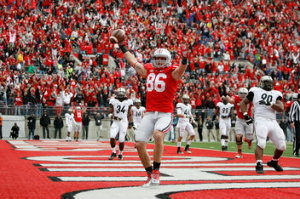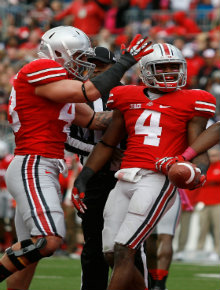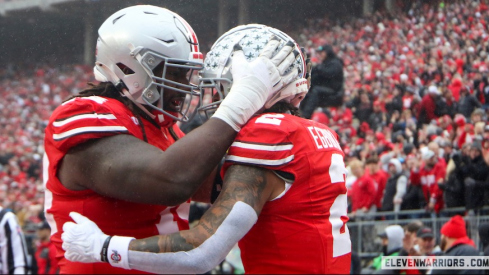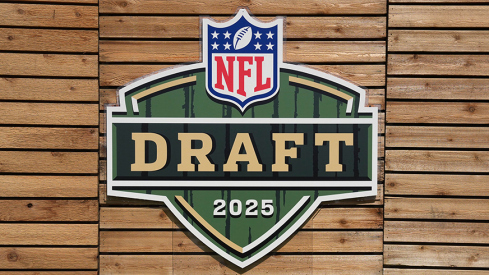Well, the numbers aren't pretty - but then again, neither was this game (at least Braxton is okay).
 Heuerman's big catch that no one saw coming
Heuerman's big catch that no one saw comingLast week we debated whether a win is just a win or if we should really be concerned about the state of the defense. It turns out it was a little of both, though the defense largely held its end of the bargain against Purdue.
Regardless of the disappointing numbers you're about to read about, they're not the most important part of this game. The will to win isn't exactly quantifiable, but this team has it in droves.
Heuerman, after catching the two-point conversion that sent this game into overtime, said, "That's one of those things that will go down in the record books forever...There's no one more deserving than Kenny, too. I love the guy. It's incredible. I get chills thinking about it."
Meyer echoed Heuerman's sentiment after the game: “Some of the efforts I saw tonight were legendary...That was a moment that I'll certainly never forget."
And neither should we.
So maybe just this once, let's look at the numbers, evaluate the state of the offense, defense, and special teams, but still remember that they don't give the whole picture of this team.
The Matchup
This is the first in just a few minor changes to the BTH weekly feature - a quick look at the matchup, based upon Football Outsiders' offensive and defensive S&P+ rankings:
| Record | S&P+ Rk | Off S&P+ | Def S&P+ | |
|---|---|---|---|---|
| Ohio St | 7-0 | 18 | 18 | 27 |
| Purdue | 3-3 | 61 | 77 | 53 |
These S&P+ rankings are comprised of a "success rate" metric and an "explosiveness" metric, which measures the point value of every yard line (and therefore every play). These measures are then adjusted by strength of schedule. A more detailed explanation is included in the link above.
The 18th-ranked Ohio State offense squared off against the 53rd-ranked Purdue defense, while the 77th-ranked Purdue offense went against the 27th-ranked Ohio State defense.
Based purely on these matchups (which don't control for type of offense or strategy, obviously), we'd expect Ohio State to overmatch the inefficient Purdue offense and score like crazy on their leaky defense.
The Offense
The biggest surprise for many was that the Purdue defense largely kept the Ohio State offense from putting up Nebraska-like points.
| 1D | 3D | 4D | Yards | Pass | Rush | TO | Penalty | QS | Sacks | |
|---|---|---|---|---|---|---|---|---|---|---|
| vs. Purdue | 15(21) | 40% | 100% | 342(3509) | 190(1612) | 152(1970) | 4(13) | 4-29(60-521) | .426 | 2(14) |
It's not that the offense was terrible against Purdue - though the 5 three-and-outs weren't exactly a positive direction to go in - but turnovers definitely played a roll in limiting the offense's scoring. Between two Braxton fumbles and an interception thrown by each quarterback, four promising drives were cut short.
The quickstrike score reflects this performance, going down from .658 points per play against Indiana to less than half a point per play against Purdue.
Ohio State's performance mirrors Notre Dame's Purdue game, actually. For a reminder, Notre Dame was held to just 52 yards rushing. Ohio State's passing game isn't yet advanced to the point that it can exploit the Purdue secondary, either.
While you'd normally be disappointed in this kind of performance, this was Purdue. I'm completely convinced that Purdue will always somehow defy the laws of football and limit Ohio State's ridiculous, Heisman-quality quarterbacks through turnovers. This is to say that the turnovers were not Braxton's fault - we cannot expect perfect performances as long as that mustache is in West Lafayette. Shudder.
One bright spot might be the penalty numbers - after having ten penalties for 91 yards against Indiana, the Buckeyes limited themselves to just four for 29 yards. That's not to say that some of these penalties weren't costly - Heuerman's block for the safety comes to mind - but at least the Buckeyes managed to cut the overall number down.
My question is where the Buckeyes go from here on offense. Braxton is "fine" but who knows how much he'll run in coming weeks. Hyde played well, but can he carry the running game? What about Rod Smith with just three yards? Can the passing game gain some consistency?
The Clock. Ohio State had one of its lowest TOP of the entire year:
| Time of Possession | # of Plays | |
|---|---|---|
| vs. Purdue | 25:11 | 68 |
| Season | (29:25) | 70 (556) |
| Last Season | 30:40 | 62 |
While this was surely part of Purdue's strategy - limit the amount of time Braxton has to make crazy things happen - it's also likely that the offense's turnovers and five three-and-outs played a big role in limiting the Ohio State time of possession.
While winning the time of possession itself isn't strongly correlated with winning football games, it can clue you in to other aspects of the game - like those three-and-outs and turnovers - that are actually important.
 Thanks, CJ.
Thanks, CJ. The Defense
The defense had an interesting game.
On the one hand, the defense managed to limit Purdue, a spread, bubble-screening offense, to just 20 points (2 from the safety). On the other hand, the Purdue's scores were classic problems with this Ohio State defense - slow linebacker play (Storm on a wheel route-running running back lol) and problems defending the perimeter short passing game (the 31-yard untouched bubble screen).
The defense continued to be strong against the run and weaker against the pass, making TerBush look pretty solid, going 19/30 and 230 yards. The defense managed to stymie the Purdue run game apart from a few QB runs, limiting Purdue backs to just a 33% efficiency rate and 117 yards.
The biggest problem statistically was the pass rush - no sacks and only 2 tackles for loss. The defensive line struggled to get adequate pressure all day, with both tackles for loss coming from linebackers (Shazier with 1.5 and Boren with .5).
| 1D | Yards | Pass | Rush | TO | TOP | TFL | Sack | INT | 3&Out | RBSR | QSand | |
|---|---|---|---|---|---|---|---|---|---|---|---|---|
| vs. PU | 16(19) | 347(3147) | 230(2168) | 117(973) | 1(14) | 34:49 | 2(36) | 0(16) | 1(11) | 4(25) | 33% | .289 |
The Purdue offense was nonetheless held to only 20 points on 69 plays, which is good for an inefficient .289 points per play - a good number for the defense. The defense also managed to force 4 three-and-outs.
While the defense performed well, we must keep in mind that Purdue was ranked 77th in offensive S&P+. They weren't that great to begin with.
Special Teams
Nobody could have realized the importance of the Piranhas' early blocked extra point:
| Blocked kicks | Tds given up | PU ko Return | osu punt avg |
|---|---|---|---|
| 1 XP | 1 (100 yard KO return) | 5/139 | 41.6 |
Tress probably watched this game at home, laughing maniacally to himself at the beauty of a blocked kick...only to cry later in the quarter when the Piranhas were knocked around, opening a lane for Akeem Hunt to take it to the house.
I'd like to give a special shoutout to David Perkins, who lit some guys up out there, ending with three tackles to his name. Seems like a different freshman linebacker plays well on special teams each week, probably because it's so instinctual - see ball, get ball.
 Hyde ran hard all game, as usual.
Hyde ran hard all game, as usual. Player Analysis
Braxton Miller. So it wasn't Braxton's best game or one that will win him the Heisman - but again, it was against Purdue, so nothing makes sense anyway. Besides, it's just good that the guy is healthy.
I don't want to spend too long analyzing Brax's performance here, but I will say: 1. Braxton will need more touchdown passes to win the Heisman in the future and 2. Even though his mechanics are much better than last year and he has a ton of potential, he's not there yet.
Kenny G. Urban puts a lot of stock in guys that can "will their team to victory", which is exactly what Kenny G's sweet, sweet music did here.
It's a good thing Kenny and Chris Fields (!) have developed such a rapport, because they made the difference in the game.
| Comp/Att | % | Yards | TD | INT | Rating | |
|---|---|---|---|---|---|---|
| Miller | 9/20(105/179) | 45% | 113(1384) | -(11) | 1(5) | 82.5 |
| Guiton | 6/11 (12/21) | 54.5 | 77 (128) | 2 | 1 (1) | 125.2 |
Running Backs. The Purdue defense was effective because it was largely able to contain Braxton Miller in the run game.
| Atts | Yards | YPC | RBSR | Ex PLays | YPC-Ex | |
|---|---|---|---|---|---|---|
| Hyde | 19(104) | 91(545) | 4.8 | 58%(60%) | 20, 17 | 3.2 |
| Miller | 10(139) | 47(978) | 4.7 | 30%(72/123) | 37 | 1.1 |
| Dunn | (12) | (60) | - | (82%) | - | - |
| Boren | (11) | (33) | - | (64%) | - | - |
| R. Smith | 2(22) | 3(131) | 1.5 | 0%(15/22) | 1.5 | |
| C. Brown | 1(8) | (70) | 9.0 | 100%(88%) | 9.0 | |
| Hall | (40) | (218) | - | (73%) | - | - |
Apart from a single 37-yard run, Braxton was held to 30% efficiency and 1.1 yards per carry on nine non-sack rushes. These are all season lows for Braxton.
Hyde was able to grind it out a bit more, while still showing that he has a bit of explosive potential there on runs of 20 and 17 yards. Hyde managed 3.2 yards against a Purdue defense that was surprisingly effective against Ohio State on the line and in the box more broadly.
If I'm advising the coaching staff, I'd probably suggest a carry or two more per game for Corey Brown. The guy only averages a carry per game (so the sample size is admittedly low) and he averages over nine yards a carry and every carry but one has been efficient. While overuse might decrease his utility (he's definitely a change of pace, wrinkle type ball-carrier), he's undoubtedly effective.
Wide Receivers. The wide receivers turned in a fairly average performance, but the ball was certainly spread around:
| Yards | Catch Rate | |
|---|---|---|
| Spencer | 15 (85) | 2/5 (7/14) |
| D. Smith | 48 (505) | 2/5 (23/41) |
| Stoneburner | 17 (150) | 1/1 (12/17) |
| C. Brown | 44 (447) | 3/4 (44/58) |
| Boren | (42) | (5/7) |
| Heuerman | 5 (86) | 2/2 (7/9) |
| Hyde | 6 (41) | 2/3 (6/7) |
| Reed | (13) | (1/1) |
| Vannett | (50) | (5/7) |
| Hall | (31) | (3/3) |
| M. Thomas | 11 (17) | 1/1 (2/2) |
| C. Fields | 44 (44) | 3/4 (3/4) |
Complete Game Coverage
A couple of things here: 1. The ball was spread around so much I thought it was the beginning of the season again. 2. Welcome to receivers board, Chris Fields. You were definitely missed.
3. Remember when Corey Brown was fast and had big play potential, but had way too many drops? Yeah... he's easily the most reliable receiver on the team with a fantastic 44/58 catch rate. Finally, Devin Smith's lower catch rate is partly due to his drops and partly due to how he's used - on deep, low-percentage bombs.
Defense. It was pretty much the Shazier and Simon show against Purdue:
| Tackles | Sacks | TFL | PBU | INT | |
|---|---|---|---|---|---|
| Shazier | 12 | - | 1.5 | 1 | |
| Simon | 9 | - | |||
| Hankins | 8 | - | |||
| Bryant | 8 | - | 1 | ||
| Barnett | 6 | - | 1 | 1 | |
| Williams | 6 | - | 1 | ||
| Boren | 5 | - | .5 | ||
| Roby | 4 | - | |||
| Goebel | 3 | - |
Shazier had a heck of a day against Purdue, flying around the field and recording 12 tackles, 1.5 for loss, and 1 pass breakup. Simon also came up big with nine tackles. This looks like the result we expected in the preseason - Shazier, Simon, and Hankins leading the way.
I was a little disappointed that Spence and Bennett didn't blow up for more, recording just 4 tackles between the two of them. All in all, the defense was about like we expected - same big play problems, but limited Purdue to just 20 points overall.

